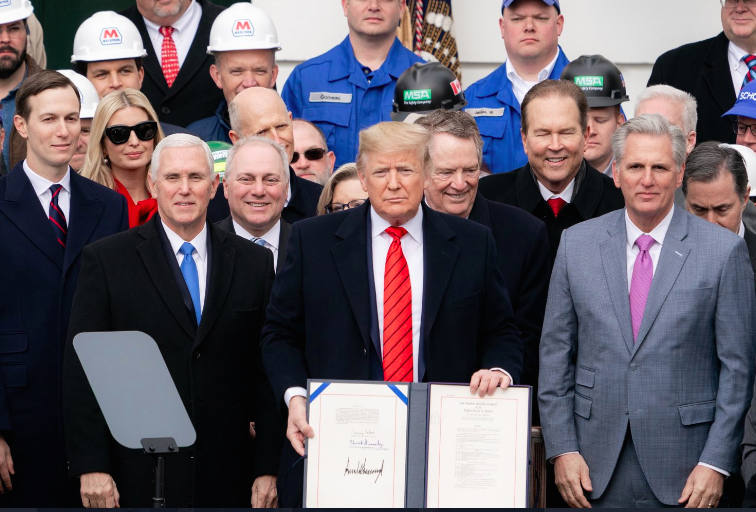
Especially when it comes to China.
President Trump held a big event on the White House lawn on Wednesday to officially sign the United States Mexico Canada Agreement (USMCA), the trade deal that replaces the old North American Free Trade Agreement (NAFTA).
The Donald, you’ll recall, made getting rid of NAFTA and bringing back factory jobs a hallmark of his presidential campaign. Not surprisingly, he used Wednesday’s signing to take a victory lap. Everybody showed up for the big party, too!
At The White House with @RepLizCheney and @RepKevinBrady to watch @realDonaldTrump sign #USMCA.
Big day for American workers! ???????? pic.twitter.com/eAkEvQEzVw
— Steve Scalise (@SteveScalise) January 29, 2020
This excited because @POTUS just signed the #USMCA into law! This is a historic victory for all American workers, especially our Arizona farmers, ranchers & manufacturers. ????: @MarshaBlackburn pic.twitter.com/pArbpWqTR8
— Martha McSally (@SenMcSallyAZ) January 29, 2020
Great to join fellow #TX leaders @JohnCornyn, @GovAbbott, @RepKevinBrady, & @RepKenMarchant this morning at the @WhiteHouse to celebrate @realDonaldTrump signing #USMCA into law. Big win for #Texas farmers, ranchers, manufacturers, & small biz owners! pic.twitter.com/4bTS6J06qE
— Senator Ted Cruz (@SenTedCruz) January 29, 2020
Well, not everybody. Some of the people who were actually very much key to the passage of the USMCA weren’t even invited to the soiree, but you know, there are probably reasons for that.
But I digress! Back to the USMCA.
The USMCA is actually the second big trade deal Trump has celebrated at the White House this month, as he signed the “Phase 1” trade agreement with China on Jan. 15.
Trump and his allies are now touting the signing of these two agreements as “promises made, promises kept.”
And you have to hand it to the Trump administration, particularly U.S. Trade Representative Robert Lighthizer. Team Trump managed to renegotiate an infamous trade deal and put a new one together that had the backing of both Democrats on Capitol Hill and many (but not all) labor unions.
The Alliance for American Manufacturing even supported the USMCA’s passage! While it certainly wasn’t perfect, it was a big improvement over NAFTA, and a good starting point for trade agreements moving forward.
But we’re not breaking out the champagne over here at AAM headquarters.
President is taking victory lap on trade, but there is much more to do to make trade policy fair and boost manufacturing workers. USMCA eliminates some of the worst features of NAFTA, but it's far from perfect. China Phase One Deal is completely inadequate for American workers.
— Scott Paul (@ScottPaulAAM) January 29, 2020
The USMCA should be considered the start, not the finish, of the work that needs to be done to reshape trade policy to benefit American workers.
Particularly when it comes to China.
President Trump held another big event at the White House a couple weeks ago for the signing of the Phase 1 China trade deal. As we pointed out at the time, that agreement is not worth celebrating.
Trump was right to take on China, and deserves credit for his willingness to get tough and force Chinese officials to come to the table.
But the Phase 1 deal is completely inadequate for American workers. It does nothing to address the fundamental issues that have led to the loss of 3.7 million jobs to China since 2001, including China’s lax labor and environmental standards, massive government subsidies, state-owned enterprises and industrial overcapacity.
Without meaningful, enforceable action on these things, unbalanced trade between the United States and China will continue. The United States is likely to see more job loss, including in the industrial heartland, where Trump made so many of his big campaign promises to bring back factory jobs.
Trump has said that he plans to get to all that sometime after the presidential election (although Chinese officials don’t seem keen to return to the table). But whether Trump is re-elected or a Democrat ends up taking over at 1600 Pennsylvania Avenue, this issue isn’t going away.
Replacing NAFTA is just the start – addressing the tough issues at the heart of our trade relationship with China is where the most work still needs to be done.
